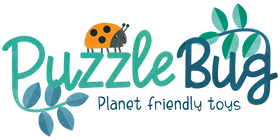Which types of puzzles are best for under 5’s?
We’ve put together a short guide to walk you through a few different types of puzzles and how they can build upon each other to help to develop different skills. We’ve given a rough age recommendation for each one, but remember it’s only a guide as all children develop different skills at different ages.
- Here’s a lovely simple design which is recommended as a first puzzle. It’s got 5 pieces which are all bright and colourful shapes. The pieces are chunky so they are easy for little hands to hold and manipulate. So, this is a good one to start developing fine motor skills and simple colour/shape recognition. It’s a self correcting design, which means that there is only one place where the pieces fit, so it takes out the element of pattern matching that you see in more complex puzzles. 12m+

- The next puzzle is a peg puzzle. Again, it helps to develop more of those fine motor skills, but it’s a more challenging design because of needing to grip the smaller pegs between the fingers. There are more pieces and peg puzzles tend to be themed around different types of animals or groups of everyday topics/objects - like this Doctor puzzle. Each piece still has it’s own hole, so again it’s a self correcting design. 1yr+

- The next step up would be something like this number puzzle. It’s got a similar number of pieces as the last puzzle but there are no pegs which make it more of a challenge to take the pieces in and out. It also introduces some simple numbers to help with early counting. 2yr+

- A more traditional jigsaw would be a good progression point from here. This has more pieces and a picture to create. So, whilst the pieces might physically fit together, you need to create the right pattern or picture - so, it introduces that additional element of problem solving. The one has a wooden tray and XX pieces which makes it easier for younger children. 3yr+

- Last up is a more complicated multi layer puzzle. This introduces the idea of problem solving and needing to complete a task in a certain order. This particular one is great for older children too as you can use it to talk about fractions.

All the puzzles we've used as examples are made by German toy and puzzle manufacturer Goki.
I hope you found this short guide interesting. Let us know in the comments if you’d like to see a guide for older children too!

